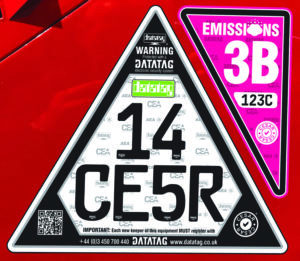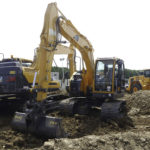 Proof of compliance to ever more stringent emissions categories is crucial if machinery is to gain access to many sites, but just how can that evidence be quickly and easily communicated? The Construction Equipment Association (CEA) thinks it has the answer.
Proof of compliance to ever more stringent emissions categories is crucial if machinery is to gain access to many sites, but just how can that evidence be quickly and easily communicated? The Construction Equipment Association (CEA) thinks it has the answer.
The guardians of the construction site gates, regulators and fleet operators all need to know exactly what the emissions standards individual pieces of construction machinery conform to, but there is still no convenient method for accessing that information.
Whilst the industry might baulk at the prospect of introducing a database of construction plant from scratch could the answer already be with us?
Its distinctive triangle is one of the most recognisable symbols in the sector, whilst the information it holds is a unique point of identification. It is, of course, the CESAR scheme, introduced some twelve years ago as a tool to reduce levels of plant theft, there are now some 300,000 pieces of equipment included, but could it be adapted to help the industry meet its clean air commitments?
 CESAR should already represent an attractive proposition for fleet operators. Equipment on which it features is now ten times less likely to be stolen and, if it is illegally removed from site, is four times more likely to be recovered. Those statistics translate into a typical 20 per cent discount on insurance premiums for protected equipment, but the ambition is to now develop the concept well beyond its original remit.
CESAR should already represent an attractive proposition for fleet operators. Equipment on which it features is now ten times less likely to be stolen and, if it is illegally removed from site, is four times more likely to be recovered. Those statistics translate into a typical 20 per cent discount on insurance premiums for protected equipment, but the ambition is to now develop the concept well beyond its original remit.
The Construction Equipment Association (CEA) conference, was the setting for a proposal from that organisation to extend the CESAR remit to encompass emissions. Although there is no official DVLA record of Non Road Mobile Machinery in the field, CESAR presently covers 60 per cent of vehicles in that category in the UK. With the onward march of the clean air zone, and major projects setting their own standards, it is now beholden on plant hirers and contractors to ensure that they are delivering compliant machines to site but, without a simple system of recognition, this remains problematic.
Paul Godfrey, Head of Special Projects at the CEA explains: “Our solution is a clear and colour coded triangle next to the existing CESAR one. It will carry a number that identifies the emissions category and a QR code that can be used to interrogate the machine spec still further. The secure system can be either factory or retro-fitted, and all responsible parties can be confident that information is accurate. The over 500 background-checked technicians who already install CESAR in the field can be utilised to deliver the complementary scheme, whilst factory processes will need little adaptation from current requirements.”
 There are, of course, logistical issues with adding the emissions component to kit that is already in use on construction sites, not least the fact that a national plant hirer’s fleet will be spread far and wide around the country. Engaging with manufacturers and ensuring that their new units are appropriately marked before they leave the factory gates will undoubtedly represent the most cost effective solution, and it is one that the CEA is well placed to promote.
There are, of course, logistical issues with adding the emissions component to kit that is already in use on construction sites, not least the fact that a national plant hirer’s fleet will be spread far and wide around the country. Engaging with manufacturers and ensuring that their new units are appropriately marked before they leave the factory gates will undoubtedly represent the most cost effective solution, and it is one that the CEA is well placed to promote.
“We can be confident that the manufacturer provided data that CESAR communicates is already 100 per cent accurate, and that’s just what plant managers need in relation to emissions,” adds Dave Luscombe of Datatag. “Given that businesses can then access the like of HS2 or Highways England projects this now represents a business opportunity.”









